Diesel Powered
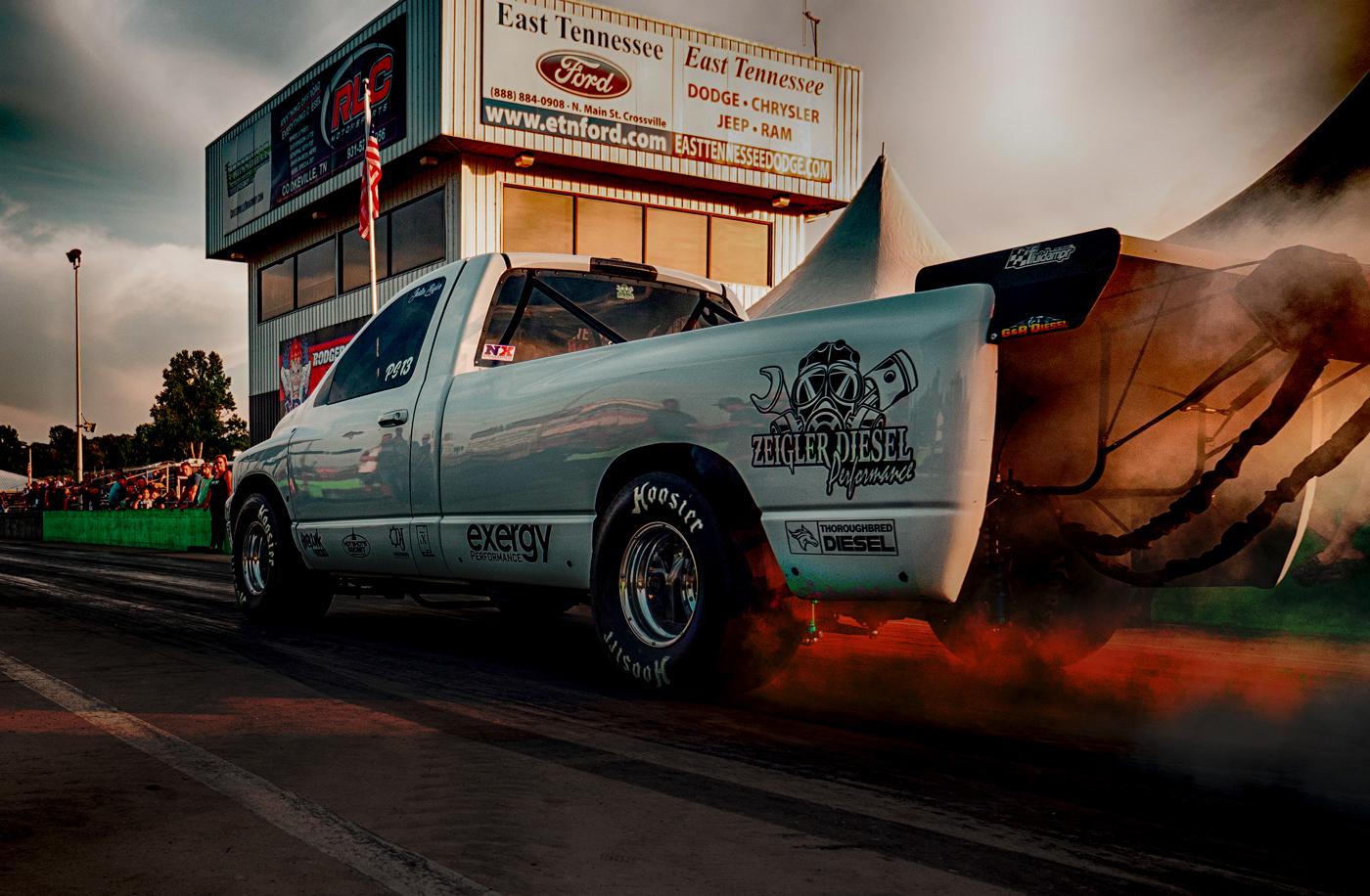
Photo courtesy of Firepunk
Whether a racer is seeking to win races in diesel competition or looking to tow more efficiently, a robust aftermarket exists to meet those needs.
The war of physics that accompanies diesel combustion can give pause to the most jaded, mechanically inclined onlooker. The forces that accompany compression of more than 20 points are what give compression-ignition diesel engines their deep-grunt output, whether the engine is used for long-haul trucking, pulling a big trailer to a racing event, or even doing battle in the competition itself.
Diesels are a growing presence in motorsports, on all levels, and technology is advancing to enhance their reliability and power, ranging all the way from complete engine builds to basic additives that help tame a diesel’s tortuous internal forces. A racer’s solution to diesel power issues may come from a new engine, a bolt-on part, or a bottle that provides protection against the relentless hammering of a diesel’s compression. Whether a racer is looking to tow more efficiently or win races in diesel competition, a robust aftermarket exists to meet those needs.
Power Packages
“We have customers all over,” said Drew Pumphrey of D&J Precision, Cambridge, Ohio, a leader in building diesel engine performance packages. “Our drag applications are becoming bigger and bigger. There’s drag racing, sled pulling, mud bogs, some with guys with monster trucks. We’ve also done lots of custom vehicles like custom hot rods with engine transplants using our engines, and hopefully, complete packages of fuel system, turbos, and everything from a 1,000-horsepower setup. We have one in process now that’s going into a Unimog. If you can dream it up, we can help with an application that meets your needs.”
D&J specializes in building and modifying the familiar Cummins turbodiesel, of all displacements, which are familiar to owners of Dodge and Ram pickups. If a customer is looking for power, a build might start with D&J’s X-beam connecting rods, machined blocks, or custom Cummins cylinder heads. Another solution is a complete engine, using a new or remanufactured block, with custom applications for either stock output or all-out performance. For drag use, one well-known D&J Precision engine is the Enforcer, built from a 6.7-liter Cummins block with an inch-thick deck plate, X-beam rods, and billet pistons. D&J refers to it as “Your Ultimate Powerhouse.”
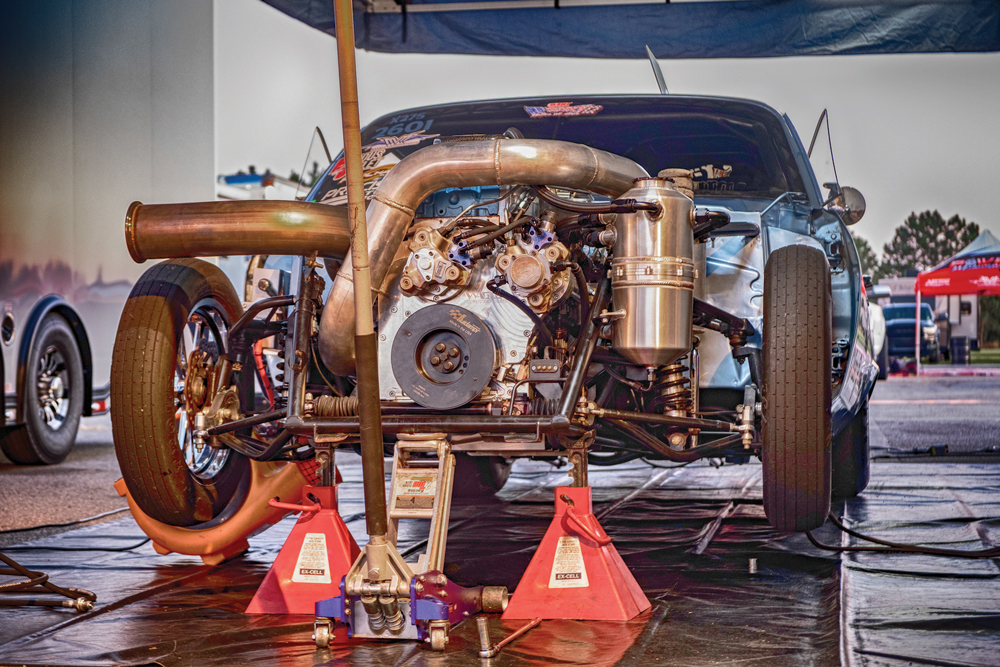
“The biggest thing is, we’re always fighting cylinder pressure, which with the torque is significant,” Pumphrey explained. “We’ve had to improve our blocks along the way, because they would crack in the cylinder walls, so we went to a sleeve setup with a 1-inch deck on top. That’s our Enforcer long block. It also has a girdle down below to keep the mains from moving around. Head flow is another consideration, so we do CNC five-axis machining on original castings to improve flow for that application. We make our own intake manifolds, we make billet connecting rods that are better than factory, build our own girdles, deck plates, all machine and head work, and all CNC work. The most we’ve ever made with the Enforcer is 3,336 horsepower at the wheels, but most customers are at 1,200 to 2,500. If you want more, we have an aluminum billet block for that purpose.”
Drag-delineated diesel engines are also pieced together and tested at Kill Devil Diesel (KDD) in Poplar Branch, North Carolina, where owner Jared Alderson got his start in the remanufacturing business before getting the opportunity to build engines for the famed Grave Digger monster truck. That, in turn, led to Alderson’s involvement in the Monster Jam entertainment series, which pulled him deeper into the world of performance diesels. Today, Kill Devil Diesel builds and ships around 250 engines a year, with high-output versions of the Ford-marketed Power Stroke V8 diesel.
“Diesel isn’t necessarily very different from a gas engine. A rod bolt is a rod bolt. Ring gap is ring gap,” Alderson said. “A lot of shops aren’t really familiar with the engine. Like, the small block Chevy is not in my wheelhouse. But I had a few diesels, such as the 6.0-liter Power Stroke, fail the same way they all fail, which forced me down the rabbit hole of what needs to be done to fix them, to address weak links. The Power Stroke keeps us busy, with occasional Duramax and Cummins builds.”
Alderson estimates that 80% of his customers are looking for enhanced towing or street performance, with the rest intending to do all-out racing. Kill Devil Diesel offers a full range of components for all three major US diesel designs and produces crate engines based on both the Power Stroke and the General Motors Duramax V8 diesel. Kill Devil Diesel also handles all four displacements of Power Stroke engines, with available components including KC turbochargers, MAHLE premium insert bearings, and billet camshaft kits. KDD’s 7.3-liter Power Stroke long-block kit machines the block using an RMC V40 CNC machine, plus CNC cylinder honing and precision balancing. A ready-to-run 6.4-liter Power Stroke crate engine from KDD incorporates a new proprietary valvetrain, new KC or MPD turbos, upgraded rods and pistons, aluminum heads, and starts out at 500 horsepower, with packages good for 1,000 horsepower available.
Elsewhere in coastal North Carolina, specifically in Moyock, JeliBuilt Performance also sells power packages for flaming-hot performance diesels, also with an emphasis on the Ford Power Stroke, particularly the 7.3-liter variety. Founder and owner Brian Jelich noted a mix of customers, with street-oriented truck owners leavened by a smaller base of hardcore diesel drag racers.
“My business is all diesel pickups,” Jelich said. “Whether the engine is diesel or gas, the basics are the same: You add fuel, add air. Everything is now about electronic control for diesels. The engine I mainly focus on is the 7.3 Power Stroke, made from 1994 to 2003. That’s what my business is wrapped around. Here, we’re increasing the fuel flow through bigger injectors, bigger turbos, and bigger oil pumps because you need to inject high-pressure oil into injectors, so you have to do dual oil pumps. The Power Strokes love nitrous, pick up a lot of power, the nitrous cleans up the smoke and also, if you spray enough of it, exhaust gas temperature also decreases by quite an amount.”
For the 7.3 Power Stroke, for example, JeliBuilt offers and installs kits ranging from an exhaust-and-tune basic setup to Stage 3 street applications with a larger turbo and 475 horsepower, up to tow packages that can also improve output to 475 horsepower. Jelich races a 7.3 engine with about 1,500 horsepower on nitrous and estimates that most JeliBuilt race engines max out at around 900. One such racer is David Beach of Palmetto, Florida, whose JeliBuilt-tuned 1996 Ford F-250’s 7.3 Power Stroke has a best time of 6.40 seconds at 108 mph in the eighth-mile.
“I built my engine myself but honestly, Brian does a lot of hands-on work and has the knowledge, especially from tuning the nitrous,” Beach explained. “He has really helped me because his truck is very similar to mine in terms of its powerplant, and what his truck was before it was modified. We are still working on the powertrain control system because it also controls the transmission in the truck. Brian helped me a lot getting the truck dialed in so we can run on the index. There is always room for improvement, but right now, we are hitting it pretty good.”
Manufactured Solutions
Not every solution involves a new engine. Addressing diesel problems can be as simple as uncapping a bottle. That’s the formula created and practiced by Hot Shot’s Secret of Mount Gilead, Ohio, which produces specialty lubricants for severe-service applications and has developed them by partnering with not only D&J Precision, but also Firepunk (see accompanying profile beginning on page 66 in this issue). Hot Shot’s Todd Fischer is well-versed in tribology, the science of lubricating properties and engineering. In the world of hot diesels, Hot Shot’s Secret’s popular product is its FR3 friction reducer, which contains three proprietary synthetic lubricants, plus an exclusive carbon nano lubricant that fills in microscopic imperfections in machined surfaces.
“The nano lubricant greatly increases oil film strength, which is where we really find the power,” Fischer explained. “Film strength means you really want it to stick, and with the pressures we’re seeing at this level of power, blowby is your killer. That’s where you’re getting power loss. Our goal—and we worked with D&J on this—is to get those rings sealed to the cylinder wall as tight as possible. Every bit of blowby is power left on the table.
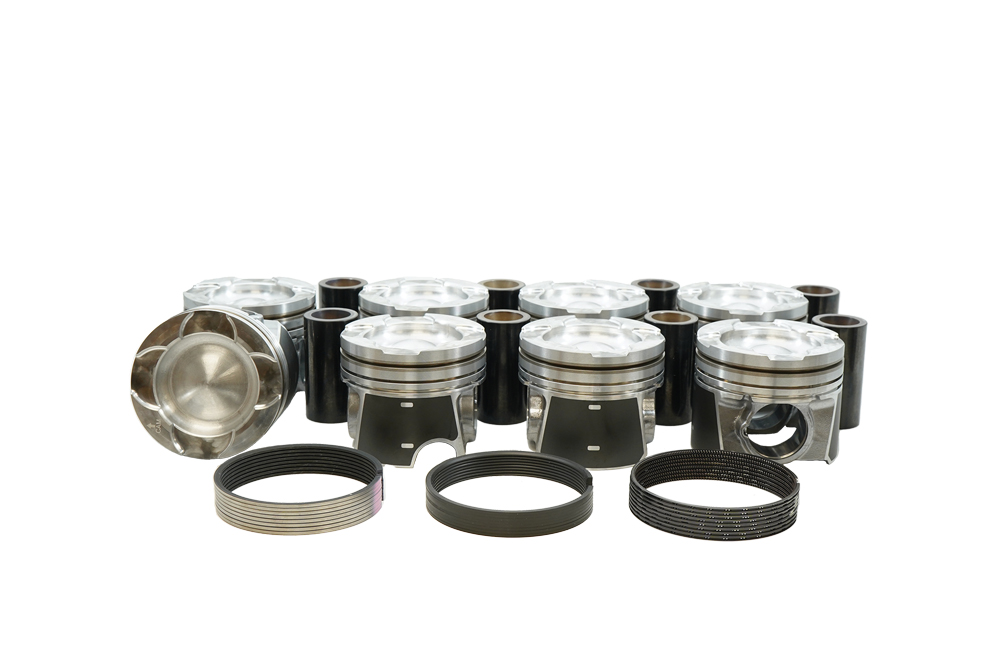
“We always see a 3–5% horsepower increase from using our lubricant,” or the lubricant is effective on engines making 300 to 2,000 horsepower, he noted. “We’re not inventing horsepower, but we’re freeing up the engine by reducing the wear, and also sealing up that ring package, so that engine will make every bit of horsepower it was designed to make. We also look at viscosity, because a thinner oil can make more power, while a thicker oil protects better. People always want to go with the lightest weight oil they can get away with,” he said. “Most importantly, you want to have proper viscosity for bearing clearances, while also having it thick enough to provide that protection. It 100% depends on the engine. We have 30, 40, 50, 60, and we’re about to introduce a really high-vis 70-weight oil for these 9,000-horsepower pulling tractor applications.”
Fischer further stated that FR3 is a synthetic lubricant that can be used with virtually any kind of motor oil. “It’s what we use in every one of our oils, from simple over-the-road trucks to the highest-adrenaline racing oil. The ‘3’ stands for the three patents on it. We’re the only people in the world who produce this product. It’s packing super-duper microscopic nano tubes as our anti-wear agent, rather than molybdenum, which is used in pretty much every single oil product. Molybdenum does a good job initially, but it breaks down. Moly is a bunch of plates that slide on each other to protect two metal surfaces, but its corners start to catch and chip up. By the time you change oil, you’ve lost a lot of protection.
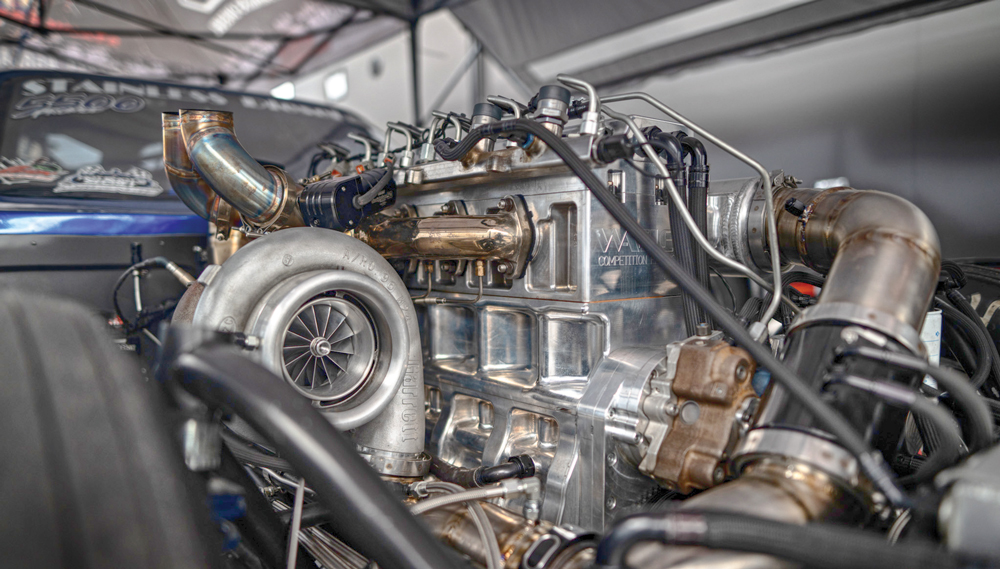
“Ours does not break down,” Fischer continued. “The nanocarbons are polarized, so they’re attracted to metal and attracted to heat. When they’re present in the engine oil, they find the hot spots in the engine with the most wear and heat. The FR3 bonds to metal and fills in any microscopic voids in the metal. That could be wear, damage, or even machining marks from a brand-new build. The flatter you can make the surface, the better. Nano will find the tolerances, find the hot spot, and won’t break down on either your first pass or on your 20th pass.”
In addition to effective lubrication under brutal conditions, hardened components that can withstand the diesel’s pounding are absolutely essential. As Fischer makes clear, blowby from leakage past the piston rings means copious lost power for a performance diesel. MAHLE Motorsports in Fletcher, North Carolina, has been conducting research on better ways to toughen up the company’s lines of piston rings for applications where nothing less than maximum resistance to blowby is acceptable.
“In terms of ring development, there are definitely some unique properties of diesel that go hand in hand with it,” Eric Grilliot said. “If you look at a piston ring, heat and pressure are the two forces that are the hardest on the rings as they’re trying to seal combustion. What are the two things a diesel does better than any other kind of engine? Heat and pressure.
“When talking about performance, normal operation means higher temperature and pressures,” Grilliot continued. “What guys are doing with 50, 60, 100 pounds of boost, at the pressures they’re trying to run, pushes those numbers up into the stratosphere. What’s important in a diesel becomes magnified in the performance world.
“I would add that the key to making it work is the advances in materials and coatings, that’s what’s leading ring development,” he explained. “Without going into specifics on types of materials, you can look at the transition to steel for making rings. It’s happening across the board, and diesels are no exception. Steel is now very common at the top ring, and you can substitute it for ductile or cast second and oil rings, but in the diesel performance world, you almost need it across the board. It’s very important for top rings to handle that pressure and not lose tension.”
Results Driven
The proof of all this technology can easily be found at the drag strip today. Hollyrock Customs in Hollywood, Maryland, is a one-stop shop for all diesel needs, whether for enhanced street performance or all-out racing. Mike Graves cut his teeth on building Duramax engines, even though Hollyrock also does engine work and rebuilds on Ford and Cummins power. Given the Duramax connection, it’s therefore fitting that the shop’s in-house dragster is powered by a very serious Duramax racing engine.
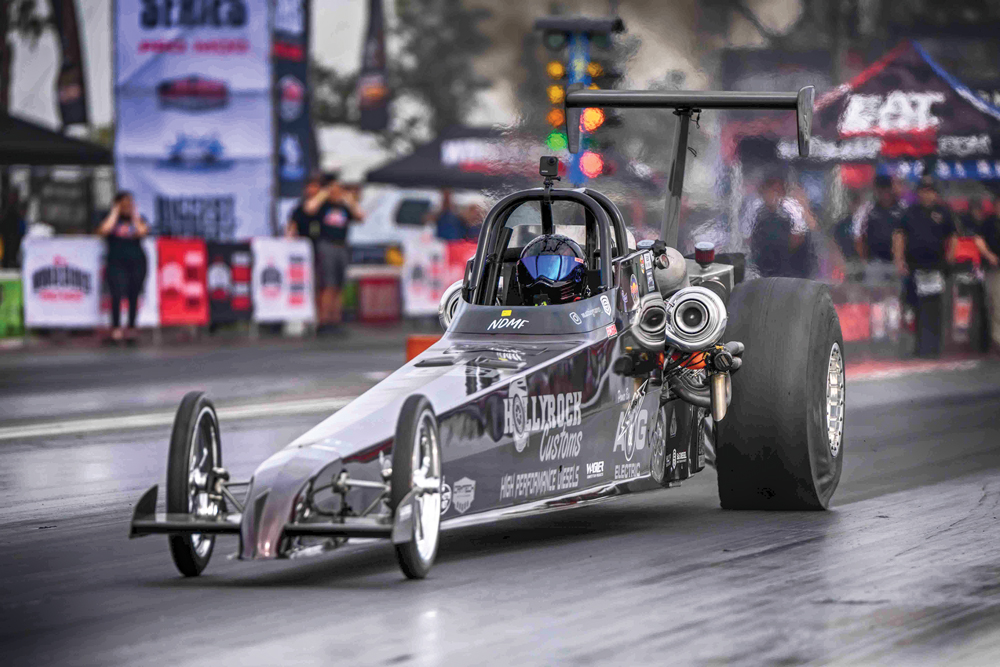
Mike’s daughter Mattie Graves, the shop’s racer, runs a twin-turbo Duramax-powered dragster with a best of 3.94 at 191 mph at Maryland International Raceway in Mechanicsville, Maryland. “Hollyrock works on everything, as a normal diesel shop, but my dad has always been a Duramax guy at heart, so we went with our hearts and put a Duramax in the dragster,” Mattie Graves said. “That’s kind of unusual, so we went with the one we know makes high horsepower, which is Wagler Competition in Indiana, and we’ve been running his engines ever since. He handles our maintenance; we send it out each winter and he freshens it. We put in pushrods, valve springs, little stuff like that that we can manage at home. All the big internal stuff, we let him handle it because he’s the expert. It hasn’t been on the dyno, but my tuner suspects it averages 2,200 to 2,500 horsepower on a real good pass.
“The biggest difference is that diesel has turbos, so you need to be able to spool them up, so the starting procedure is a lot different than for a gas vehicle,” she explained. “Most gassers light the second bulb, get on the trans brake and just mat it to the floor on the two-step. With a diesel, you can’t do that, because you have to let the turbos spool, which takes three to seven seconds. We leave at about 5,200 rpm. We run a three-speed Coan transmission, same as the TH400 but with different internals and externals. We’re all very close in the diesel community, and if somebody needs help, you help them, even though we all run such unique and different combinations. If we can help, we’ll do it in a heartbeat. With us being a Duramax family, we’re a little bit out there.”
SOURCES
D&J Precision Machine
djprecisionmachine.com
Hollyrock Customs
hollyrockcustoms.com
Hot Shot’s Secret
hotshotsecret.com
JeliBuilt
jelibuiltperformance.com
Kill Devil Diesel
killdevildiesel.com
MAHLE Motorsports
mahlemotorsport.com
 MEMBERSHIP LOGIN
MEMBERSHIP LOGIN JOIN PRI
JOIN PRI


